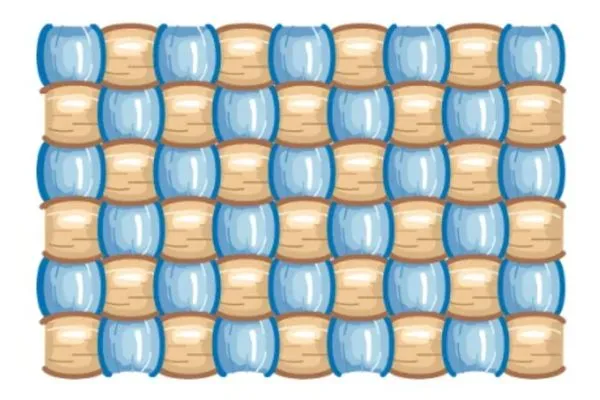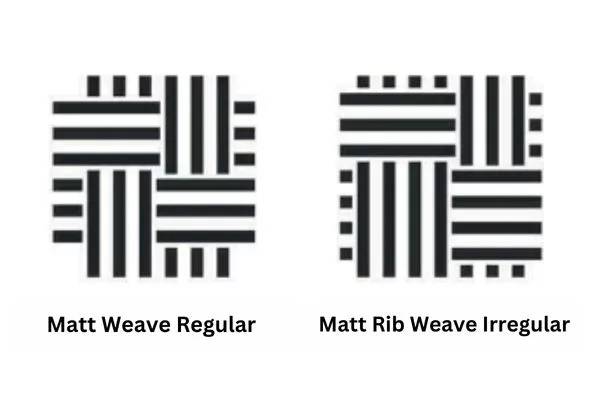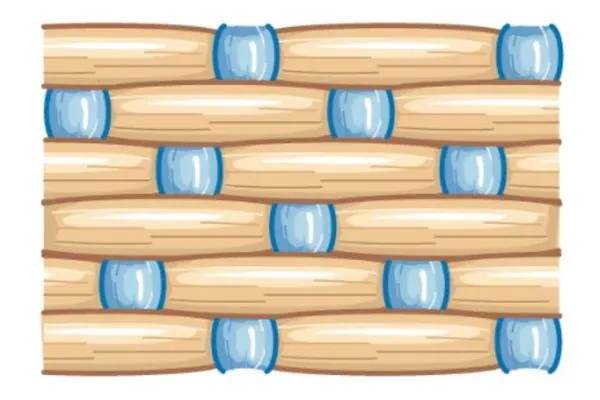The plain weave is obtained by raising all even-number warp ends at one pick and raising all the odd-numbered at the other pick. The repeat contains 2 ends and 2 picks. Both sides of the weave are similar.
Table of Contents

Characteristics of Plain Weave
- Made from all kinds of textile raw materials and yarns.
- Threads interlacing in an alternative order.
- Each thread gives the maximum amount of support to the adjacent threads.
- The texture is stronger and finer than any other ordinary cloth.
- Two heald shafts are sufficient to produce a plain weave when the number of ends is large, 4 and 6 heald shafts are used with skip draft.
Ornamentation of Plain Weave
- By using extremely fine yarn.
- By using coarse yarn.
- Threads of different colors are combined in check form.
- The threads in both warp and weft vary in color and in thickness.
- By using fancy slub yarn.
- By combining different orders of denting.
- Using two warp beams that are differently tensioned produced a “ Seer sucker stripe”.
- By using high twisted warp and weft yarn to produce crepe weave.
- By using different textile raw materials to produce union fabric.
Classification of Plain Cloth 1
Approximately square clothes:
- The cloths in which the warp and weft counts are the same.
- The ends and picks per inch are equal.
- The warp and weft cover factors are approximately equal.
- The warp and weft are equally prominent.
- The crimps are also equal.
150 x 150
———- x 58”
40 x 40
Classification of Plain Cloth
Warp Faced Cloths:
- The clothes in which the warp cover factor is more than weft.
- The ends are more than the picks per inch.
- The warp is prominent on both sides.
- The warp yarn is finer than the weft yarn.
150 x 30
———- x 56”
50 x 8
Classification of Plain Cloth
Weft Faced Cloths:
- The clothes in which the weft cover factor is more than warp.
- The picks are more than the ends per inch.
- The weft is prominent on both sides.
- The weft yarn is high-quality than the warp yarn.
32 x 148
———- x 57”
7 x 60
Another Classification
1 . Balanced cloth
- The clothes in which the warp and weft count are the same.
- The ends and picks per inch are equal. c. The warp and weft cover factors are approximately equal.
- The warp and weft are equally prominent. e. The crimps are also equal.
150 x 150
———- x 58”
40 x 40
Another Classification
2. Unbalanced cloth
- The ends and picks are the same but the warp and weft counts are different.
- The warp and weft counts are similar but the ends and picks per inch are different.
- The warp and weft counts and the ends and picks per inch are different.
- Derivatives of plain weave Plain
- Rib Matt Warp rib Weft rib Regular Irregular StitchFancy
Warp Rib
- It produces a rib or cord effect in the weft direction.
- Finer yarn is used as warp and coarser yarn is used as weft yarn.
- The number of ends is more than the number of picks in unit space.
- Low twisted yarn is used as weft.
- Warp yarn single yarn and weft yarn bundle or grouped yarn.
- Regular: F. N. X/X
- Irregular: F. N. X/Y

Weft Rib
- It produces a rib or cord effect in the warp direction.
- Finer yarn is used as weft and coarser yarn is used as warp yarn.
- The number of picks is more than the number of ends in unit space.
- Low-twisted yarn is used as a warp.
- Weft yarn single yarn and warp yarn bundle or grouped yarn.
- Regular: F. N. 1/1 (x)
- Irregular: F. N. 1/1 (x+y)

Matt Weave
- Matt weave is constructed by extending the plain weave in both warp and weft directions.
- Combination of warp and weft rib.
- Loose structure.
- Matt weaves tend to give a smooth surface of the fabric and more flexible fabrics than plain weaves.
- Regular: F. N. x/x (x)
- Irregular: F . N. x/y (x+y)
- Stitched: F. N. x/x (x)
- Fancy: F. N. x/x (x)

Satin weave
- The fabric surface is very smooth and lustrous.
- By using low twisted yarn and by increasing EPI, smoothness can be increased.
- Only one interlacement between one warp and one weft.
- This interlacement point is covered with an adjacent long float of yarn.
- Loose structure compared to plain and twill weave.
- No visibility of the twill line in this weave.
- Widely used in the case of jacquard design.

Classification of Satin
- Warp satin
- Weft sateen
- Regular
- Irregular
